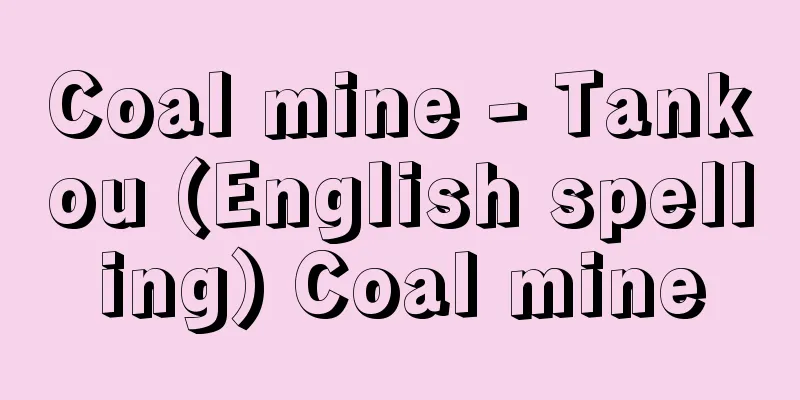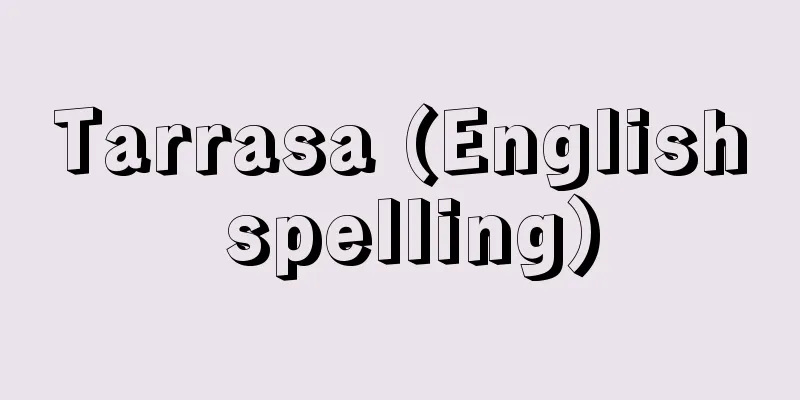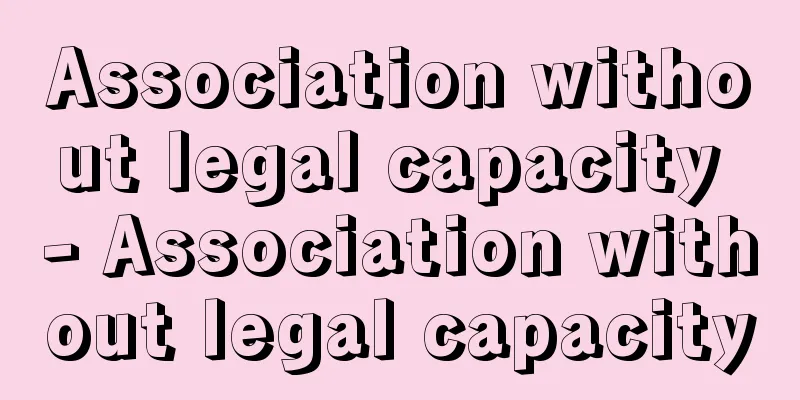Coal mine - Tankou (English spelling) Coal mine

|
Coal is buried underground. Coal mining is the process of extracting it and transporting it to the surface. Freshly mined coal usually contains impurities such as rocks, and is called kirikomitan (or raw coal). This kirikomitan is then sorted and separated to produce refined coal, which can then be sold. The place and facilities where the above process takes place are called a "coal mine." [Toshiro Isobe] Conditions for establishing a coal mineA coal mine can also be defined as a business activity that produces and sells coal, but the following two requirements must always be met: (1) Needless to say, coal is an energy source, and currently, alongside oil and natural gas, it is one of the three major sources of fossil energy for humankind. Moreover, mining coal requires electricity, labor, and other tangible and intangible energy. In other words, unless the energy invested in extracting coal energy is less than the coal energy gained, there is no value in digging up coal. Currently, operating coal mines (meaning mining) largely satisfy this condition. Incidentally, the decision as to whether or not to mine diamonds and other gemstones and metallic minerals is based solely on their economic value, not on energy. (2) In the process of sorting the raw coal extracted, making it into commercial coal, selling it to users, and receiving payment (also called the coal price or the mine's net income, or Yamate for short), various expenses are incurred, including the cost of materials, labor, power, and depreciation of equipment, taxes, public charges, loan repayments, and interest payments. The profit from the mine is what remains after these expenses are paid. From this, head office expenses and sales expenses are further deducted to determine the net profit of the company. However, the amount of coal that can be extracted from any coal mine is limited, and it must be closed down at some point. Therefore, it is necessary to continue by setting up new mining areas, constructing new mines, redeploying equipment and personnel, and resuming production in the hope of ensuring the continuity of the coal mining enterprise. For this reason, a portion of the operating profit from the old mine should be accumulated and used to fund the development of new mines. The second requirement for a coal mine to be established is that the above-mentioned economic viability is realized. [Toshiro Isobe] Type of coal mineCoal mines can be broadly classified into "open-cut coal mines" and "underground coal mines." For the former, please refer to the "coal mining" section for details. Underground coal mines are coal mines that have underground tunnel networks for the purpose of coal extraction, and we will only explain them here. [Toshiro Isobe] Main tunnel frameworkTo build underground tunnels, an entrance must be created. Determining the location of the entrance is extremely important, and making a mistake could even determine the fate of a coal mine. The selection criteria include accessibility, and being the starting point of the tunnels that allows easy access to the underground mineable coal layers. Other considerations include that the site must be less susceptible to natural disasters such as floods and cliff collapses, that there is enough land to build an office, a reeling area (a gathering place for workers to receive instructions for the day's work), power equipment to send vehicles into the mine, a waiting line for vehicles, a repair shop, and a materials storage area, and that there is good access to water. On the other hand, several mine entrances are always needed, some of which are air intakes to bring fresh air into the mine, and the rest are exhausts to allow the dirty air to flow through the mine and expel it. Once the location of the entrance has been decided, the main coal transport tunnels, main entrance and exhaust tunnels, and manways for the workers to enter and exit the tunnels are excavated from the entrance as the starting point for mining the coal seams. These tunnels are divided into two groups. One group extends from the shoulder toward the depths and is called a vertical shaft and an inclined shaft. However, depending on the condition of the coal seam, horizontal tunnels that do not go deep but go to the back are sometimes excavated, which are called tunnels. The other group is a horizontal tunnel that connects the vertical shaft and the inclined shaft, and is also called a single-pane tunnel. The inside of the mine is therefore divided into a checkerboard pattern by these two intersecting groups of skeletal tunnel networks. On the other hand, coal seams were horizontal when they were deposited, but over the tens or hundreds of millions of years they have been subjected to geological changes, and their strike and inclination have changed in various ways due to faults, folding, etc. The main framework structure must be constructed appropriately to accommodate these changes. For example, vertical shafts are used for steeply sloping coal seams, inclined shafts are used for coal seams with relatively gentle inclinations and little geological change, and tunnel excavation is better when the syncline and anticline axes are close to horizontal and the coal seam is above the mine entrance level. Coal mining always starts from a shallow coal seam and progresses to deeper areas. When using the longwall method, it is common technical practice for the face length to be 100 to 200 meters, and the vertical distance between the plates is determined based on that length. However, if the coal seam slope is 60 degrees or more, the face length is often several tens of meters, and the vertical distance between plates will also be several tens of meters. From the plate tunnels, access tunnels that face the coal seam are dug at intervals of 100 to 500 meters. It is desirable for these access tunnels to be roughly the same length, so the plate tunnels are horizontal tunnels at a fixed distance from the coal seam and parallel to the strike of the coal seam. In underground mining areas, vertical shafts or inclined shafts are usually built at horizontal intervals of 2,000 to 3,000 meters, and these inclined shafts and vertical shafts are connected by horizontal single-pane tunnels excavated every few dozen meters, forming a rectangular grid structure. Next, I will explain about intake and exhaust, coal transportation, and pedestrian traffic. I have already explained that some of the mine entrances are used for intake and others for exhaust. So, which part of the air flowing inside the mine is intake and which part is exhaust? In a word, the air flow before it enters the work area where people are working is intake, and the air flow after that is exhaust. Ventilation is performed to dilute and exhaust toxic and harmful gases that gush out from inside the mine, but in addition, in order to prevent the spread of disasters such as explosions, gas leaks, and mine fires in a certain mine area from spreading to other areas, the intake air is divided at each branch point of the mine tunnel, and ultimately there is one branch for each work area. This is called the "independent division method" and is the principle of ventilation. After washing the work area, the independent inflow air rejoins in sequence to become a large flow, and is released when it reaches the exhaust mine entrance. Now, since coal is transported by train using locomotives or by belt conveyors, various machines and electrical equipment are concentrated in the coal transport tunnels, and cannot be installed in the exhaust tunnels where gases and other substances are mixed. For this reason, the air inlet panel and the main air inlet tunnel before the branch are often used as coal transport tunnels. Many people also use the air inlet tunnels for entering and ascending the tunnels for the above reasons. However, in winter, where the temperature drops to below -10 degrees Celsius, the main exhaust tunnel is often used for entering and ascending the tunnels. Finally, there is the method of arranging the inlet and exhaust tunnels. Placing the inlet and exhaust tunnels in a row in the center of the mining area (not necessarily in the center) is called the "central method," while arranging the exhaust tunnels around the periphery of the mining area, away from the inlet tunnels, is called the "corner method." While the corner method is recommended for safety reasons, the central method allows for the shortest time from the start of business to operations. For information on coal mining methods and coal preparation, please refer to the sections on "Coal Mining" and "Coal Preparation." [Toshiro Isobe] Japanese coal minesCoal has been referred to as "burning stone" in historical documents since the 15th century, but it wasn't until 1873 (Meiji 6) when the Miike and Takashima coal mines were established as government-run mines that coal began to be extracted using modern methods. After that, coal was transferred to private management, and coalfields in Kyushu, such as Chikuho, Karatsu, Sasebo, Munakata, and Fukuoka, coalfields in Hokkaido, such as Ishikari, Kushiro, Tenpoku, Rumoi, and Tomamae, and coalfields in Honshu, such as Joban and Ube, were developed, and the number of coal mines and production volume both gradually increased. In other words, by 1912 (Taisho 1), Japan's annual coal production had reached 19.64 million tons. After that, production volume gradually increased until 1919, reaching 31 million tons, but due to the effects of the recession following World War I, production growth temporarily slowed until 1931 and 1932 (Showa 6 and 7). After 1933, when the Sino-Japanese War expanded into the Pacific War, production volume skyrocketed in line with the national policy of increasing coal production, and by the time of Japan's defeat in 1945, more than 50 million tons were being mined annually. However, due to the sense of despair that swept the country after the war and the single-minded focus on increasing production during the war, the mines fell into disrepair and production plummeted to less than half, to the 20 million tons range, resulting in a serious energy shortage. Incidentally, in 1946 (Showa 21), the domestic coal production was 22.5 million tons and the number of coal mines was 407. Therefore, the government and GHQ (Supreme Commander for the Allied Powers) considered the increase in coal and steel production to be the most important items for postwar recovery and reconstruction, and implemented the so-called "priority production method" which involved special allocation of labor, materials, and food to these two. As a result, production exceeded 30 million tons in 1948, exceeded 40 million tons three years later in 1951, and reached the 50 million tons mark in 1957 (Showa 32). At that time, there were 864 coal mines and about 360,000 workers. However, the subsequent "energy revolution" brought about a crisis for the survival of coal mines, and the government established the Coal Mining Temporary Measures Law and the Coal Mining Council to protect and nurture the coal industry, but was unable to prevent the industry from declining. Furthermore, since 1973 (Showa 48) and until recently, there have been repeated reviews of coal due to concerns about oil supplies, but the price difference between domestic and imported coal has rather accelerated the decline of domestic coal. Thus, the decline of the coal industry over the past 20 to 30 years is not a trend unique to Japan, and other major coal-producing countries in the world, such as the UK, Germany, and France, have followed a similar path, although with some differences. In addition to the energy revolution based on the advancement of oil mentioned above, another factor that cannot be overlooked is the problem of coal mines themselves, namely the decrease in the amount of coal that can be extracted safely at low cost due to the deepening and remoteness of mining areas. In contrast, coal production in Japan has been declining year by year since peaking at 55.3 million tons in 1961 (Showa 36), and by 1984, there were only about 30 coal mines, and production was below 18 million tons. Then, in 1999 (Heisei 11), annual production was about 3 million tons, mainly produced by two major coal mines, one each in Kyushu and Hokkaido. In 2001, the Ikeshima coal mine in Kyushu closed, and in 2002, the Pacific coal mine in Hokkaido closed, leaving only small-scale coal mines. If we look at the situation objectively, there is even a concern that coal mines may disappear from the country in the near future. Meanwhile, domestic coal demand in Japan is not declining at all, but rather is on the rise, with 130 million tons needed per year for power generation, steelmaking, cement, etc. in the future. And now and in the future, the country is almost entirely dependent on imports from overseas. The biggest reason for this is that domestic coal is more than 10,000 yen more expensive per ton than imported coal. In other words, it is no exaggeration to say that Japan's coal industry was first forced to succumb to the oil offensive, and then snuffed out by overseas coal.
Coal Mine SafetyThe history of coal mining is also a history of fighting disasters. Looking at the rate of accidents in Japan since the Meiji era, it was only after 1951 (Showa 26), about 80 years after the start of modern coal mining, that the number of deaths at work per 1 million tons of production fell to below 20. Furthermore, it was not until 1966 that this figure fell to below 10.
Coal mining villageCoal mines are rarely found in livable flat areas or near cities, and most are located in remote mountainous areas. For this reason, in addition to mining facilities, they also need to build residential and living facilities for employees, which will become completely worthless once mining of coal resources is finished. This is borne out by the fact that hundreds of coal mines have closed since 1961, and the areas have become ghost towns. Furthermore, after coal mining was withdrawn, mining damage such as land subsidence and sinking occurred, depopulation due to population dispersion, and regional exhaustion occurred. As a countermeasure, huge amounts of money were invested in "coal mining area promotion," "restoration of mine damage," and "measures for coal miners who lost their jobs," which shows how large the scars left by the mine closures are. When there was a coal mine, all commerce, industry, transportation, and even education and entertainment existed for the maintenance, development, and welfare of the mining village. In other words, the mining village was the living area of employees created by the company for the single purpose of coal production. The mine manager is fully responsible for production and ensuring safety, and at the same time, he acts as the head of the village. And since the residents there have little connection with the outside world, they develop a unique mining temperament. They live in close, attentive relationships with their neighbors, but also in an environment where privacy is difficult to maintain, as everyone's lives are completely visible. However, they are also a generally optimistic group that enjoys their daily lives. [Toshiro Isobe] "Window to the North" by Sugiyama Hideki (1943, Shogakukan)" ▽ "Chikuho Coal Mine Picture Scroll" by Yamamoto Sakubei (1973, Ashi Shobo)" ▽ "History of the Labor Society of Coal Mines" by Ichihara Hiroshi (1997, Taga Publishing)" ▽ "Historical Development of the Coal Industry" by Tsubouchi Yasue (1999, Bunken Publishing)" ▽ "Trends of Japan's Mining Industry, compiled by the Research and Statistics Department of the Minister's Secretariat of International Trade and Industry, various annual editions (Research Institute of International Trade and Industry)" [References] | | | | [Supplementary information] |(1) Sedimentation pond (2) Slag heap (3) Tar, ammonia, benzene fractional distillation (4) Coke oven (5) Raw coal hopper, coke quenching tower (6) Winding tower (7) Gas tank (8) Electric fan (9) Power station, boiler room (10) Screen, water sorter, loading equipment (11) Winding machine room (12) Shaft building (13) Pit office and reloading area (14) Winding tower (15) Pit timber storage area (16) Ventilation shaft with ladder (17) Sub-shaft (for personnel and materials transportation) (18) Main shaft (for coal transportation) (19) First horizontal gallery (20) Side gallery (21) Second horizontal gallery (22) Pick face (conveyor-operated) (23) Third horizontal gallery (24) Bottom water sump, water tunnel, drainage equipment (25) Large inclined shaft (26) Inner shaft (27) Loading area (28) Exhaust shaft (29) Mine remains (30) Heavy equipment mechanized coal mining face (31) Steep inclined layer pick mining face (32) Pick digging face (33) Filling remains (34) Coal seam (35) Spiral chute inner shaft (36) Inclined shaft (drilling in progress) ©Shogakukan Library "> Examples of coal mine facilities ©Shogakukan "> Relationship between single-pane tunnels, inclined shafts, vertical shafts, and face length ©Shogakukan "> Layout of entrance and exhaust ports The inside of the mine was ventilated by long bamboo pipes with the nodes removed, and the mined coal was transported up by a winch. "Tenko Kaibutsu" Volume 2 "Yakuseki" (Burnt Stone) 11th National Diet Library Collection "> Coal mining in "Tenkou Kaibutsu" Source: Shogakukan Encyclopedia Nipponica About Encyclopedia Nipponica Information | Legend |
|
石炭は地下に埋蔵されている。それを採掘して、地表まで運搬する作業が採炭である。採掘したばかりの石炭には、通常岩石等の不純物が混じっていて、切込炭(きりこみたん)(または原炭(げんたん))という。切込炭は「選炭」という操作によって、石炭分のみを選別分離し精炭(せいたん)がつくられ、商品となる。以上のプロセスを行う場所と設備を「炭鉱」という。 [磯部俊郎] 炭鉱の成立条件「炭鉱は石炭を生産販売する企業活動である」とも定義できるが、つねに以下の二つの要件が満足されていなければならない。 (1)いうまでもなく石炭はエネルギーであり、現在、石油、天然ガスと並んで人類の三大化石エネルギー源の一つである。しかも、これを採掘するには、電力、労力、その他有形、無形のエネルギーが消費される。すなわち、石炭エネルギー採取のため投下されるエネルギーが獲得される石炭エネルギーより少量でなければ、石炭を掘る価値はまったくない。現在、稼行(採掘の意味)している炭鉱では大幅にこの条件を満足している。なお、ダイヤモンド等の宝石類や金属鉱物などはエネルギーではなく、経済価値のみで採掘の可否が決まる。 (2)採掘した原炭を選別して商品炭にし、利用者に売り渡して代金(炭代(たんだい)または山元手取(やまもとてどり)、略して山手(やまて)ともいう)を受け取るまでには、資材費、労務費、動力費および設備の償却費、租税公課、借入金の返済および支払い利子等々の費用がかかる。これら諸経費を支払った残りが山元利潤である。さらにこれから本社費および販売経費が差し引かれて企業としての純利益となる。しかし、どの炭鉱でも可採炭量は有限であり、いずれ閉山しなければならない。したがって、引き続いて新しい採掘区域を設定し、新炭鉱を建設して、設備、人員等を配置転換し、生産を再開して、石炭企業の永続性を期待する必要がある。このため、旧炭鉱の営業利潤のうち一部を蓄積し、新鉱開発資金に充当すべきである。以上のような経済性が成り立つことが、炭鉱成立に必要な第二の要件である。 [磯部俊郎] 炭鉱の種別炭鉱を大きく分類すれば、「露天(ろてん)炭鉱」と「坑内掘(こうないぼり)炭鉱」に分類される。前者については、「採炭」の項に詳述してあるのでそこを参照されたい。坑内掘炭鉱とは、石炭採掘のため地下に坑道網が展開されている炭鉱で、ここではそれについてのみ説明する。 [磯部俊郎] 主要坑内骨格構造地下に坑道をつくるには、入口となる坑口(こうぐち)を設けなければならない。坑口位置の決定はきわめて重要で、これを誤ると炭鉱の死命を制することさえある。選定要件は、交通の便、地下の可採炭層群に容易に接近できる坑道の起点であること等である。また、洪水・崖(がけ)崩れ等の天災地変の影響を受けにくいこと、事務所、繰込場(くりこみば)(労働者が当日の作業指示を受けるための集合場所)、坑内へ送る動力設備、車両の待線(まちせん)、製修工場および資材置き場などをつくるための用地が確保できること、水の便のよいことも考慮しなければならない。 一方、坑口はつねに複数個必要で、そのうちいくつかは坑内に新鮮な空気を取り入れる入気(にゅうき)坑口で、残りは坑内を流動して汚れた空気を排出するための排気坑口である。 坑口位置が決まると、そこを起点として、炭層群の採掘のため、主要運炭坑道、主要入排気坑道および坑内作業員の入昇坑(にゅうしょうこう)のための人道等が掘削される。これら坑道は二群に分類され、その一群は肩(かた)から深(ふけ)へ向かって延びていくもので、立坑(たてこう)および斜坑(しゃこう)である。しかし、炭層の状況により深へ向かわず奥部に進む水平坑道を掘削することもあり、これを通洞(つうどう)という。他の一群は、前記立坑および斜坑を結ぶ水平坑道であり、片盤(かたばん)坑道ともいう。したがって坑内は、これら相交わる二群の骨格坑道網によって碁盤目のように区分されている。一方、炭層は堆積(たいせき)当時は水平であったが、その後数千万年あるいは数億年の間に地質的変動を受け、断層、褶曲(しゅうきょく)等のため、走向(そうこう)・傾斜が種々に変動している。主要骨格構造はこの変動に対応して適切につくられなければならない。たとえば、急傾斜炭層には立坑で、比較的傾斜が緩くあまり大きな地質的変動の少ない場合は斜坑で、向斜(こうしゃ)・背斜(はいしゃ)軸が水平に近く、炭層が坑口水準より上部に存するときは通洞開削によるほうがよい。 採炭は、つねに浅い区域にある炭層から順次深い所に及んでいく。長壁(ちょうへき)式採炭法を用いるとき、切羽(きりは)面の長さは100ないし200メートルが技術上の常識であり、その長さにあわせて片盤間の垂直距離を定める。ただし炭層傾斜が60度以上にもなれば、切羽面長は数十メートルぐらいにとることが多く、そのときは片盤垂直距離は数十メートルとなる。片盤坑道からは、炭層に当てる立入(たていれ)坑道を100ないし500メートル置きに掘る。これら立入坑道はだいたい同じ長さであることが望ましいので、片盤坑道は炭層と定距離にある水平坑道であり、炭層の走向に平行な坑道となる。 地下の採掘区域では、立坑または斜坑は、水平距離2000ないし3000メートル置きにつくるのが普通で、これら斜坑・立坑を垂直距離数十メートルごとに掘削した水平片盤坑道で結ぶ構造になっている。すなわち長方形の碁盤目構造である。 次に入排気、運炭および人の通行について述べる。坑口のうちいくつかは入気に、ほかは排気に用いることはすでに説明した。では坑内を流れる気流中どこまでを入気、どこからが排気というかについて、ひと口にいえば、人が働いている作業場に入るまでの気流が入気、それ以後が排気である。坑内から湧出(ゆうしゅつ)する有毒・有害ガスを希釈排出するために通気を行うが、そのほか、ある坑内地区に爆発、ガス突出、坑内火災等の災害が起きたとき、他区域への拡大伝播(でんぱ)を防止するため、入気は坑道の分岐点ごとに分流し、最終的には1作業場1分流にする。このことを「独立分流方式」といい通気上の原則となっている。独立分流入気は、作業場を洗ったのち、ふたたび順次合流して大きな流れとなり、排気坑口に達して放流される。 さて、運炭には機関車を用いる列車方式、あるいはベルトコンベヤー等によるため、各種の機械および電気設備が運炭坑道に集中していて、ガス等の混入している排気坑道には設置できない。そのため、入気片盤および分流前の総入気坑道が多くの場合運炭坑道になっている。人の入昇坑も前記の意味で入気坑道が多い。しかし、冬期間など気温が零下十数℃以下にもなる所では、総排気道を入昇坑に用いる場合も少なくない。 最後に入排気坑口の配置の方法である。採掘区域の中心(かならずしも中心であることは必要ない)に入排気坑道を並べて配置するのを「中央式」、入気坑口から離して採掘区域周囲に排気坑口を配列する方法を「対隅式」という。保安上は対隅式が推奨されているが、起業開始より営業までの期間が短縮できるのは中央式である。 なお、採炭法、選炭については「採炭」「選炭」の項を参照されたい。 [磯部俊郎] 日本の炭鉱石炭が「燃える石」として古文書にとどめられているのは15世紀以降のことであるが、近代的方法によって採掘され始めたのは、1873年(明治6)三池(みいけ)および高島炭鉱が官営として発足したころである。その後、民営に移管されるとともに、九州では筑豊(ちくほう)、唐津(からつ)、佐世保(させぼ)、宗像(むなかた)、福岡等の諸炭田、北海道では石狩(いしかり)、釧路(くしろ)、天北(てんぽく)、留萌(るもい)、苫前(とままえ)等の諸炭田、加えて常磐(じょうばん)、宇部(うべ)等の本州炭田も開発され、炭鉱数、生産量ともにしだいに増加していった。すなわち、1912年(大正1)には、日本の年間石炭生産高は1964万トンにも達していた。その後1919年までは徐々に生産量が上昇して3100万トンにもなったが、第一次世界大戦後の不況の影響で、1931、1932年(昭和6、7)までは生産の伸びは一時鈍化した。そして日中戦争が太平洋戦争へと拡大された1933年以降、石炭増産の国策に沿って生産量はうなぎ登りに上昇、1945年の敗戦を迎えるころには、年5000万トン余を掘っていた。 しかし、戦後の国全体を覆った虚脱感と戦時中の増産一本やりの採掘のため、坑内は荒廃し、生産は一挙に半分以下の2000万トン台に急落し、深刻なエネルギー不足を招来した。ちなみに、1946年(昭和21)の国内産炭量は2250万トン、炭鉱数は407であった。そこで政府およびGHQ(連合国最高司令部)は、戦後の復興と再建には石炭と鉄鋼の増産が超重点項目であると考え、この二者に対して労働力、資材、食糧の特配等を伴ういわゆる「傾斜生産方式」を実施した。そのかいがあって、1948年に3000万トン突破、3年後の1951年には4000万トンを超え、1957年(昭和32)には5000万トンの大台に達した。当時、炭鉱数864、労働者数は約36万人であった。 しかし、その後「エネルギー革命」という、流体エネルギーである石油の進出は炭鉱存続の危機をもたらし、政府は石炭産業の保護育成のため、石炭鉱業臨時措置法、石炭鉱業審議会等を発足させたが、石炭産業の斜陽化は抑止できなかった。また1973年(昭和48)以来最近まで再三の石油供給の不安に起因する石炭見直しがあったが、輸入炭との間の価格差がむしろ国内炭低落傾向に拍車をかけていた。 このように、ここ20~30年の間に、石炭産業が衰退したのは日本だけの特有の傾向ではなく、世界でも主要な産炭国であったイギリス、ドイツ、フランスなども多少の違いはあるが、同じような道程をたどっている。原因は、前述の石油の進出に基づくエネルギー革命に加えて、炭鉱自身の問題として、採掘区域の深部化、奥部化のため、低コストで安全に採掘できる炭量の減少も、また見逃せない要因の一つである。 ひるがえって、日本では、石炭生産量は1961年(昭和36)の5530万トンをピークに逐年減少、1984年には、炭鉱数30内外、1800万トンをも下回る生産量に、さらにその後、1999年(平成11)には、年産約300万トンを、主として九州と北海道に各1鉱ずつ存続している大手2炭鉱で採掘しているありさまであった。2001年には九州の池島炭鉱が閉山、2002年には北海道の太平洋炭礦が閉山し、小規模経営の炭鉱が残るのみとなった。しかも冷静に判断してみれば、近い将来、国内から炭鉱が消えてしまう懸念すらある。 一方、日本国内での石炭需要はけっして消滅の傾向にあるどころか、むしろ増大の方向にあり、将来とも発電、製鉄、セメントなどに年1億3000万トンが必要とされている。そして現在も将来もほとんど全量、海外からの輸入に頼っている。なぜ輸入なのかという最大の理由は、国内炭は輸入炭に比べて、1トン当り、約1万円以上も高いからなのである。つまり日本の石炭産業は、まず石油攻勢に屈服させられ、次には海外炭によって息の根を止められたといっても過言ではない。
炭鉱保安炭鉱の歴史は災害との闘いの歴史でもある。日本の明治以来の災害率をみても、生産量100万トン当りの殉職者数が20人以下になったのは近代炭鉱発足後約80年経過した1951年(昭和26)以降である。さらに、これが10人未満になったのは1966年よりあとである。
炭鉱集落炭鉱は住みやすい平地とか、都市周辺には少なく、多くは山間僻地(へきち)にある。そのため、採掘設備のほか、石炭資源の終掘後は、まったく無価値なものになる従業員の居住・生活施設も、あわせて建設しなければ産炭活動ができない。1961年(昭和36)以来、数百の炭鉱が閉山したが、その地区のゴーストタウン化をみれば、このことが裏づけられる。さらに、石炭鉱業が撤退したあとは、地盤の陥没・沈下等々の鉱害、人口離散による過疎化、地域の疲弊が発生する。その対策として「産炭地振興」「鉱害復旧」「炭鉱離職者対策」などに巨費が投下されていて、閉山の爪跡(つめあと)の大きさを物語っている。 炭鉱があったときは、すべての商・工・運輸業、教育・娯楽さえ炭鉱集落の維持発展と福祉のため存在していた。つまり、石炭生産という単一目的のため企業の造成した従業員の生活圏が炭鉱集落である。炭鉱長は生産・保安確保に全責任があると同時に、集落の長としての働きもする人である。そして、そこの住民は、外界とはあまりつながりがないため、一種独特な炭鉱人気質をもつようになる。彼らは親しく細やかな近所づきあいと、お互いの生活が丸見えであるという、プライバシー護持のむずかしさのなかで生きている。しかし、概して楽天的で、日々の暮らしのなかで生活を楽しんでいる集団でもある。 [磯部俊郎] 『杉山英樹著『北方の窓』(1943・小学館)』▽『山本作兵衛著・絵『筑豊炭坑絵巻』(1973・葦書房)』▽『市原博著『炭鉱の労働社会史』(1997・多賀出版)』▽『坪内安衛著『石炭産業の史的展開』(1999・文献出版)』▽『通商産業大臣官房調査統計部編『本邦鉱業の趨勢』各年版(通商産業調査会)』 [参照項目] | | | | [補完資料] |(1)沈殿池 (2)ぼた山 (3)タール、アンモニア、ベンゼン分留抽出 (4)コークス炉 (5)原炭ホッパー、コークス消火塔 (6)巻上げ塔 (7)ガスタンク (8)扇風機 (9)発電所、ボイラー室 (10)スクリーン、水選機、積み込み設備 (11)巻上げ機室 (12)立坑建屋 (13)坑事務所および繰込場 (14)巻上げ塔 (15)坑木置場 (16)梯子付き通気立坑 (17)副立坑(人員昇降および材料運搬) (18)主立坑(石炭運搬) (19)第1水平坑道 (20)沿層坑道 (21)第2水平坑道 (22)ピック切羽(コンベヤー使用) (23)第3水平坑道 (24)坑底水溜、通水坑道、排水設備 (25)大斜坑 (26)坑内立坑 (27)積み込み場 (28)排気立坑 (29)採掘跡 (30)重装備機械化採炭切羽 (31)急傾斜層ピック採炭切羽 (32)ピック掘りによる総ばらし採炭切羽 (33)充填跡 (34)炭層 (35)スパイラルシュート坑内立坑 (36)斜坑(掘進中)©小学館ライブラリー"> 炭鉱の施設例 ©Shogakukan"> 片盤坑道と斜坑、立坑、切羽面長の関係 ©Shogakukan"> 入排気坑口の配置法 節を抜いた長い竹管によって坑内の換気を行い、採掘した煤炭(石炭)は巻上げ機で運び上げる。『天工開物』 中巻 「燔石」 第11国立国会図書館所蔵"> 『天工開物』にみる石炭採掘 出典 小学館 日本大百科全書(ニッポニカ)日本大百科全書(ニッポニカ)について 情報 | 凡例 |
Recommend
Shaykh al-Ishrāq (English spelling)
…He was born in Suhrawardy, Iran, and died in Ale...
Hachiro Arita
Foreign Ministry bureaucrat and politician. Born ...
Polypore - Polypore
These mushrooms have holes in the spore-forming ar...
ṭanbūr (English spelling) tanbur
…However, waterwheels continued to be used as a p...
Annexation of Austria - Austria Heigou
The annexation of Austria by Nazi Germany. Also kn...
Fasting - Danjiki
Fasting means abstaining from all or a specific t...
Anshan Steel Works
A steelworks in Liaoning Province, northeastern Ch...
Theory of relativity - relativity theories
A general term for the special theory of relativi...
Telitoxicum
…Poison is obtained from various plants, but the ...
Devil's Violin
…In 1847, she married the famous dancer F. Cerrit...
Retinol
… [Various vitamins] Below, we will explain the p...
Nordic
…This later became the famous Holmenkollen (Norwe...
theological ethics
…In Catholic theology, it is a branch of theology...
Victor Vasarely
1908‐97 A French painter of Hungarian origin, he s...
Learning lesson - Kakukun
...A collection of biographies of high priests fr...

![Kannawa [Hot Springs] - Kannawa](/upload/images/67d03c2c5cfc1.webp)







